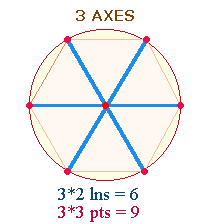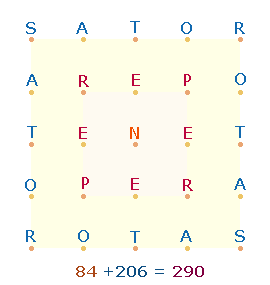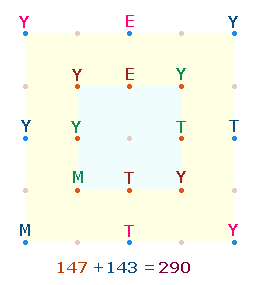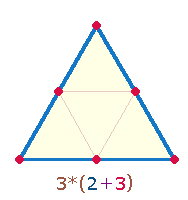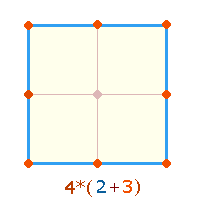Alphabets; factoral values
Shakespeare's
Epitaph
F. Meaning of the
Letter Y; the Y-words and the SATOR
Square
E. Gematric aspects of the 4 Y-Words
F. Meaning of letter Y
I. The
numbers 21 22 23
II. Union of the Y-words with the SATOR
Square
III. Union of the Y-words with PENSATOR
G. Y-words in St. Luke's Annunciation
This study of
the letter Y is very special and, without some knowledge of previous
pages,
rather difficult to understand.
|
6 |
GOOD FREND FOR IESVS SAKE FORBEARE |
|
6 |
TO DIGG THE DVST ENCLOASED HEARE. |
|
8 |
BLESTE BE YE MAN YT SPARES THES STONES |
|
8 |
AND CVRST BE HE YT MOVES MY BONES. |
I. The numbers 21 22 23
1.
Shakespeare used the Greek letter Ypsilon in 4 words each consisting
of two letters. This is so unusual that it seems Shakespeare gave the letter Y special attention and significance.
The order of letters in the Elizabethan alphabet was identical with the Latin
alphabet up to the 20th letter V/U. Then the letter W was inserted, which
moved the following three letters XYZ upward by one position. As the
letters WXZ are missing in the text, Y remains the only letter that
differs from its place in the Latin alphabet. Since Shakespeare had a
stupendous knowledge of numbers and their meanings, we'll have to examine the
relationship of the letter Y to the numbers 22 and 23.
2.
The Romans integrated the Greek letter Y and Z to their 21-letter
alphabet. The experts of Roman numerology understood the meaning of the single
numbers 21 and 23: The numbers 2 and 1 refer to the two concentric circles of the
tetraktys star: 2 area units for the outer ring and 1 unit for the inner
circle. The numbers 2 and 3 are corresponding radial elements:
|
|
The tetraktys star contains 3 geometrical figures of
double rhombus (DR) consisting of 21 elements, 7 points + 4 triangular areas and 8+2 lines. However, if the
frame of the DR is numbered like an 8, and afterwards the remaining 6 elements of the middle
part, two points are occupied with two numbers: 13-5 and 1-17 so that the end number
is 23:
|
|
3. The number 22 refers to two DR, each consisting of 11 elements.
How does the number 22 associate with the
shape of Y? The tetraktys star is constructed by extending the
segment lines of the hexagon until they intersect. If it is encompassed by a
circle line, the area of the inner circle expands by 2 units. This fact might
be represented by the two fork-like lines of the Y.
The connection between the
areas of the two concetric circles and their radial elements becomes evident if
the numerical value (NV) 22 is complemented by its factoral value (FV) 13
(2*11),
which can be regarded as the essence or nucleus of 22. Again, the single numbers
refer to the areas of the two circles and their radial elements, the inner
circle with 1 area unit and 3 radial elements and the outer area ring with 2 units and 2 radial elements.
4. The numbers 22 and 23 are related to each
other with regard to 2+2 and 2+3 diametrical elements of the DR which as a whole
represents 2+1 area units.
If the 4 diametrical elements of the outer ring are related to the
whole circle, there is a ratio of 4:9 elements and 2:3 area units, if related
to the small circle only, it is 4:5 and 2:1, in all 13+9 or 8+14 = 22 elements and 5+3 or 4+4 = 8 area units. The same process, starting from the 5 diametrical elements of the inner circle, results in 5+4 and 5+9 = 10+13 or 9+14 = 23 elements and 2+5 or 3+4 = 7 area units. The added area units correspond to 8 lines and 7 points of the DR-frame.
5. With regard to the 1+2 area units of the two
circle parts the letters Y and Z together with N have three lines in
common. Theologically, the three letters refer to God as a communion of three
divine persons. As the 3 lines of these letters are delimited by 4 points, the triangular
side of the tetraktys is a plausible model.
The lower part of the
letter Y can be regarded as the first divine person from
whom the other two emanate.
The Y,
however, can also be regarded from top to bottom, with the two lines uniting in
one. Shakespeare might have felt the shift of the Y from 22nd to 23rd place a step of
progress from classical antiquity to the Age of Christianity. As a humanist-minded
poet Shakespeare aspired to unite these two historic eras.
II. Union of the Y-words with the SATOR Square
1. The numeric value (NV) of SATOR is 69 = 3*23. One constructional
idea – beside some others – inherent in SATOR is derived from the
three axes of the hexagon with the two vowels corresponding to the 3*2 = 6 radial lines and the three
consonants to 3*3 = 9 points. Accordingly,
the NV of AO is 6+9 and of STR 6*9:
|
|
2.
The word SATOR or ROTAS can be read 4 times round the outer
frame of the square. When Shakespeare decided to use Y 4 times, he obviously
thought of the four sides of a square. The NV 23 suggests a square whose sides consist of 2 lines and 3 points. If he counted
the NV of Y according to the Latin alphabet with 22, he added the single
numbers to 2+3 so that one side of the square consists of 4 lines and 5 points. In this way
the 8 letters of the y-words can be placed on the points of 2 square frames:
|
|
|
By giving the letter Y
the NV 23 for the inner and 22 for the outer frame, Shakespeare achieved the
numeric sum (NS) 290 of the SATOR Square. The factoral sums (FS) also have to be
considered:
|
|
Inner frame |
Outer frame |
Tot. |
||||
|
|
SQ |
EPI |
sm. |
SQ |
EPI |
sm. |
|
|
NS |
84 |
147 |
231 |
206 |
143 |
349 |
580 |
|
FS |
70 |
142 |
212 |
166 |
102 |
268 |
480 |
|
sm. |
154 |
289 |
443 |
372 |
254 |
617 |
1060 |
As the epitaph contains
the name IESVS, whose NV+FV is 70+36 = 106, there is reason to
assume that the total result 1060 was intended part of
Shakespeare's gematric construction.
There is the letter N in the centre left.
Its NV 13 and identical FV can be added to the total sum of the inner and the
outer frame and then are divisible by 6: 443+13 = 456; 617+13 = 630; 456+630 =
1086; their ratio is 6*(76+105). It's interesting that the FV of 1086 keeps the same order
of single numbers, leaving out the nil: 1086 = 2*3*181
> 186.
3. The number 106 turns out to be an important gematric component of
the SATOR Square if the NS of one side of the outer and inner square frames are
added. The following table also includes the other 3 values:
|
|
NS |
FS |
FV1 |
FV2 |
sm. |
|
|
SATOR |
69 |
54 |
26 |
11 |
160 |
|
|
REP |
37 |
30 |
37 |
10 |
114 |
|
|
sm. |
106 |
84 |
63 |
21 |
274 |
2*137 |
|
NV |
55 |
14 |
13 |
10 |
|
|
|
sm. |
69 |
23 |
|
|
||
The number 106
has to be understood as twice the sum of 53 represented by 5 and 3 letters of SATOR and REP. The meaning of the
two numbers is rooted in the radial elements of the tetraktys star with its two
concentric circles: The 5 radial elements of the outer and 3 of the inner circle
represent 3 and 1 area units:
|
|
Theologically speaking,
the ratio 3:1 refers to God's
trinitarian union.
The even numbers 10 and 6 are on the one hand due to the
double occurrence of radial elements in a circle, on the other hand they are
sums of the numbers 1-4 and 1-3. While the number 4 represents the 3+1 area units of the two
separate circles, the number 3 refers to the 2 area units of the
outer ring and 1 unit of the inner circle. The
radial elements corresponding to 4+3 area units are 8+5 = 13. As composite numbers
the two aspects form the number 137, which as double result 274 appears in the total
sum of the 4 values in the table above.
The FS 84 is both equalled and
explained by the sums of FV1 63+ FV2 21: 63 means three sides of a triangle 3*(2 points + 1 line) and 21 adds another side to
form a square. The number 21 functions as a complement part to the whole of 84: 63+(63+21).
The same applies to the numbers 69 and 23. They refer to an
extended triangle and square with 2 lines and 3 points for each side:
|
|
|
Two other synonymous terms for SATOR (69, 54)are GENITOR (84, 76) and CREATOR (76, 71). The 7 letters of GENITOR have an average NV of 12,
its FV 76 is at the same time the NV of CREATOR.
4.
Shakespeare has taken account of both geometrical
concepts: on the one hand the ratio 2:1 in the NS 147 = 7*21 of the 4 Y-words , on the other hand
the ratio 2:3 in the word MOVES (69, 38) and the 4 letters Y. The combined values show
an astonishing ratio between FS and NS:
|
|
Y-words |
SATOR |
sm. |
|
NS |
147 |
69 |
216 |
|
FS |
142 |
38 |
180 |
|
180:216 = 36*(5:6) |
|||
It's the same ratio as
for the values of the inner frame of the SATOR Square: 70:84 = 14*(5:6). This is interesting, as 70 is the NV for IESUS. It establishes a
relationship to GENITOR. In fact, in the prologue of his gospel St. John defines IESUS as the pre-existent LOGOS: "Through him all
things were made".
5.
The common divisor 36 in the above table is
the FV of IESUS. Its addition to 70 = 35+35 effects the inversion 106 = 53+53. Here the number 70 appears as part of the
whole 70+36 = 106. The FV of both numbers leads
back to 69,
the NV
of SATOR:
|
|
NS |
NS+FS |
sm. |
|
|
70 |
106 |
|
|
FV |
14 |
55 |
69 |
III. Union of the Y-words with PENSATOR
1.
If we accept that Shakespeare intended to relate and tune
the Y-words to the values of the SATOR Square and combine them, it should
be the more the case with the word PENSATOR, which is made up of the 8 different letters of
the square and which shows a parallel structure of 4 pairs of letters:
|
|
PE |
NS |
AT |
OR |
sm. |
FV |
|
NS |
20 |
31 |
20 |
31 |
102 |
22 |
|
FV |
9 |
31 |
9 |
31 |
80 |
|
|
FS |
13 |
21 |
20 |
26 |
80 |
13 |
The NS 102 and FS 20 have the FV 22+13, which is 22 + its FV 13. The number 22 refers to the elements
of two rhombi united in one double rhombus with 2*4 lines along its frame.
As has been mentioned already, Shakespeare used these numbers twice as
composite numbers 2213 and 1322. The first is made up of the
total NS+FS 1242+971 of the epitaph, the second of 615+707 referring to the
frequency of letters for the words VESTA and IESUS.
The two numbers 22 and 13 may have served
Shakespeare as one reason for his double count of the letter Y. In fact, Shakespeare
possibly had the two FV 9 and 31 in mind, when defining
the total FS of the epitaph to be 931, with Y to be counted 22 and its FV 13.
2.
The following table shows how the values of PENSATOR and the of the 22- and 23-count agree with each
other:
|
|
NS |
|
FS |
|
sm. |
|
PENSATOR |
102 |
|
80 |
|
26*7 |
|
23-count |
147 |
21*7 |
142 |
|
17*17 |
|
22-count |
143 |
|
102 |
17*6 |
35*7 |
|
|
392 |
|
324 |
|
716 |
|
|
56*7 |
|
54*6 |
|
4*179 |
The two products 56*7
and 54*6
reveal a
close relationship. Their sums are divisible by 11 and 13, as is the number 143 (11*13), the gematric value
for PATER NOSTER. The NS of PENSATOR goes with the 22-count to form
the ratio 49*(5:3) with the 23-count, and the FS goes with the 23-count to form
the ratio 6*(37:17) against the 22-count. So NS and FS should be dealt with
separately.
PENSATOR and the 22-count are
also compatible in their combined NS+FS, being both divisible
by 7.
3.
The four Y-words can be arranged either in a line or along
the double rhombus, with which I would like to begin:
|
|
The three counts
produce the following NS and FS for each of the four triangles:
|
NS |
1 |
2 |
3 |
4 |
|
FS |
1 |
2 |
3 |
4 |
|
|
P |
32 |
19 |
32 |
19 |
102 |
|
25 |
14 |
32 |
9 |
80 |
|
23 |
46 |
17 |
42 |
42 |
147 |
|
46 |
12 |
42 |
42 |
142 |
|
22 |
44 |
17 |
41 |
41 |
143 |
|
26 |
12 |
32 |
32 |
102 |
|
|
122 |
53 |
115 |
102 |
392 |
|
97 |
38 |
106 |
83 |
324 |
|
324:392 = 4*(81:98) |
|||||||||||
In the following table two rhombi (1+2/3+4) and two double triangles (1+4/2+3) are grouped together.
In both cases there are ratios, more conclusive, however, appear the ones of
the double triangles, because each forms one half of an octahedron together
with a second double rhombus:
|
1 |
2 |
|
1 |
4 |
|
1 |
2 |
|
1 |
4 |
|
|
122 |
53 |
175 |
122 |
102 |
224 |
97 |
38 |
135 |
97 |
83 |
180 |
|
3 |
4 |
|
2 |
3 |
|
3 |
4 |
|
2 |
3 |
|
|
115 |
102 |
217 |
53 |
115 |
168 |
106 |
83 |
189 |
38 |
106 |
144 |
|
175:217 = 7*(25:31) |
135:189 = 27*(5:7) |
||||||||||
|
224:168 = 56*(4:3) |
144:180 = 36*(4:5) |
||||||||||
4.
In the following table the letters are arranged in a line.
As the NV
of PENSATOR and the 22-count combine to be divisible by 7, the two values should
be added before being connected with the 23-count.
|
|
1 |
2 |
3 |
4 |
5 |
6 |
7 |
8 |
|
|
P |
E |
N |
S |
A |
T |
O |
R |
|
|
Y |
E |
Y |
T |
Y |
T |
M |
Y |
|
P |
15 |
5 |
13 |
18 |
1 |
19 |
14 |
17 |
|
22 |
22 |
5 |
22 |
19 |
22 |
19 |
12 |
22 |
|
|
37 |
10 |
35 |
37 |
23 |
38 |
26 |
39 |
|
|
47 |
72 |
61 |
65 |
||||
|
|
119 |
126 |
||||||
|
|
119:126 = 7*(17:18) |
|||||||
The values of the outer pairs are
to the inner pairs 112:133 = 7*(16:19). Now the 23-count is
added:
|
|
1 |
2 |
3 |
4 |
5 |
6 |
7 |
8 |
|
P+22 |
37 |
10 |
35 |
37 |
23 |
38 |
26 |
39 |
|
23 |
23 |
5 |
23 |
19 |
23 |
19 |
12 |
23 |
|
|
60 |
15 |
58 |
56 |
46 |
57 |
38 |
62 |
|
|
75 |
114 |
103 |
100 |
||||
|
|
189 |
203 |
||||||
|
|
189:203 = 7*(27:29) |
|||||||
The values of the outer pairs are
to the inner pairs 175:217 = 7*(25:31). Two other pairings
add up to 224:168 and correspond to the
above figuration in the double rhombus.
5.
The same procedure applies to the FS:
|
|
1 |
2 |
3 |
4 |
5 |
6 |
7 |
8 |
|
|
P |
E |
N |
S |
A |
T |
O |
R |
|
|
Y |
E |
Y |
T |
Y |
T |
M |
Y |
|
P |
8 |
5 |
13 |
8 |
1 |
19 |
9 |
17 |
|
22 |
13 |
5 |
13 |
19 |
13 |
19 |
7 |
13 |
|
|
21 |
10 |
26 |
27 |
14 |
38 |
16 |
30 |
|
|
31 |
53 |
52 |
46 |
||||
|
|
84 |
98 |
||||||
|
|
84:98 = 14*(6:7) |
|||||||
The values of the outer pairs are
to the inner pairs 77:105 = 7*(11:15). The 23-count now
follows:
|
|
1 |
2 |
3 |
4 |
5 |
6 |
7 |
8 |
|
P+22 |
21 |
10 |
26 |
27 |
14 |
38 |
16 |
30 |
|
23 |
23 |
5 |
23 |
19 |
23 |
19 |
7 |
23 |
|
|
44 |
15 |
49 |
46 |
37 |
57 |
23 |
53 |
|
|
59 |
95 |
94 |
76 |
||||
|
|
135:189 = 27*(5:7) |
|||||||
The ratios 135:189 and 180:144 are identical with
those dealt with in the double rhombus. The values of the second ratio are
divided into two by grouping them like this:
|
1 |
4 |
5 |
8 |
2 |
6 |
3 |
7 |
|
5 |
13 |
8 |
10 |
||||
|
44 |
46 |
37 |
53 |
15 |
57 |
49 |
23 |
|
90 |
90 |
72 |
72 |
||||
One final interesting aspect is
that if the outer and inner ratios of NS and FS are added so that the
common divisors and the ratio numbers (rn) are separately added, the result is 102 again:
|
|
div. |
rn1 |
rn2 |
|
NS |
7 |
25 |
31 |
|
FS |
27 |
5 |
7 |
|
|
34 |
30 |
38 |
|
|
34 |
68 |
|
Written: January 2009


